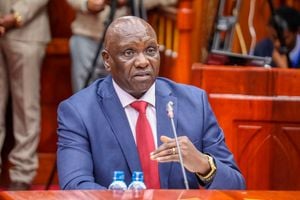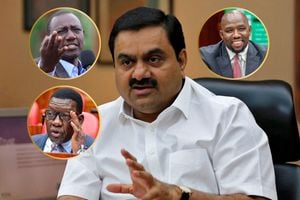Kibaki launches development blueprint

President Kibaki hands over the Vision 2030 reports to Planning minister Wycliffe Oparanya after the official launch at KICC, Nairobi. Looking on are Prime Minister Raila Odinga and Vice President Kalonzo Musyoka.
President Kibaki has launched the development blueprint that aims to transform Kenya into an industrialised country.

President Kibaki hands over the Vision 2030 reports to Planning minister Wycliffe Oparanya after the official launch at KICC, Nairobi. Looking on are Prime Minister Raila Odinga and Vice President Kalonzo Musyoka. Photo by PPS
However, achieving the goal will be a mammoth task as the country requires approximately Sh1.6 trillion to implement priority projects that will help the country achieve and maintain a 10 per cent economic growth by 2012.
According to the government, a chunk of the funds, Sh1.1 trillion, is expected to be financed through the public-private partnership and the balance of Sh500 billion paid through normal budgetary allocation.
However, speaking during the launch of the Vision 2030 policy document at the Kenyatta International Conference Centre, President Kibaki expressed confidence that the country will achieve the industrialisation target.
About 98 flagship projects have been identified for implementation and out of these, 21 will be implemented in the six priority economic sectors of agriculture, tourism, manufacturing, wholesale and trade, business process outsourcing and financial services.
The President said his government will lay the foundation that will see Kenyans have an economy whose Gross Domestic Product per capita will be over $300 or six times the current rate.
“By the year 2030 we expect to be a country that will be so well integrated by good infrastructure of roads, railways, waterways and airports that it will be impossible to refer to any part of our country as being remote,” he said in his speech.
He urged both private and public sectors to work towards achieve the 10 per cent economic growth rate target by 2012 as indicated in the document.
The document, launched amid pomp and colour, will succeed the Economic Recovery Strategy for Wealth and Employment Creation (ERS) which expires at the end of June.
The ERS, launched in 2003, is credited for lifting the country from economic abyss to registering impressive economic growth rates.
Vision 2030, whose aim is to make Kenya globally competitive and prosperous, will be hinged on three major pillars; economic, social and political.
The economic pillar aims to improve the prosperity of all Kenyans by achieving a 10 per cent economic growth rate by 2012 and maintaining it for the next 22 years.
The political pillar aims at achieving a democratic political system that respects the rule of law and protects the rights and freedoms of Kenyans.
The social pillar seeks to build a just and cohesive society with social equity and a clean, secure environment.




